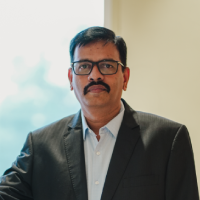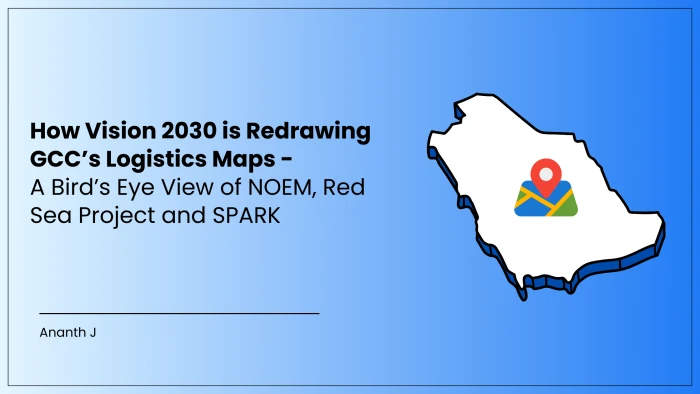Saudi Arabia is undergoing a profound transformation, systematically positioning itself as a dominant logistics powerhouse through Vision 2030’s ambitious infrastructure investments. The Kingdom’s strategic mega-projects – NEOM, the Red Sea Project, and King Salman Energy Park (SPARK) – are fundamentally reshaping regional supply chains and establishing new benchmarks for trade efficiency across the Gulf Cooperation Council (GCC). This blog explores how these initiatives are redefining the logistics landscape, driving economic diversification, and cementing Saudi Arabia’s role as a pivotal node in global commerce.
Vision 2030: Laying the Foundation for a Logistics Hub
Vision 2030, launched in 2016, is Saudi Arabia’s comprehensive national transformation plan. One of its core pillars is the development of world-class logistics and infrastructure, aiming to diversify the economy, reduce dependence on oil, and position the Kingdom as a global logistics hub. The National Transport & Logistics Strategy (NTLS) and the National Industrial Development and Logistics Program (NIDLP) together plan investments of approximately SAR 1 trillion (USD 266 billion) in transport and logistics by 2030.
The Kingdom’s official targets include:
- Raising the logistics sector’s contribution to GDP from about 6% in 2023 to 10% by 2030.
- Improving the World Bank’s Logistics Performance Index (LPI) ranking from 38th in 2023 to the top 10 globally by 2030.
- Expanding the number of integrated logistics zones from 22 in 2023 to 59 by 2030.
- Attracting $10 billion in foreign investment into logistics by 2030.
- Creating over 200,000 jobs in the logistics sector by 2030.
These objectives are supported by regulatory reforms, digital transformation, and a strong emphasis on sustainability and workforce localization.
NEOM: Engineering the Future of Smart Logistics
NEOM stands as the flagship of Saudi Arabia’s logistics transformation, a $500 billion+ investment in a futuristic mega-city spanning 26,500 km² along the Red Sea, bordering Egypt and Jordan. NEOM is envisioned as a “living laboratory” for sustainable urbanism and advanced logistics, powered entirely by renewable energy and designed to diversify the Saudi economy beyond oil dependency.
(A) Logistics Innovations and Infrastructure
Oxagon: NEOM’s industrial and logistics hub, Oxagon, is set to become the world’s largest floating industrial complex. It will feature a fully automated port and logistics hub, integrating smart supply chain networks, advanced robotics, and end-to-end digital transparency for manufacturers.
The Line: This 170 km-long linear city will have no cars or streets, relying on high-speed transit and walkability. All logistics and deliveries will be managed through underground and automated systems, powered by AI and big data.
Cognitive Logistics: NEOM aims to be the world’s first cognitive city, using AI, IoT, and big data to anticipate and facilitate logistics needs, from real-time cargo tracking to predictive maintenance and drone-based deliveries.
(B) Strategic Location and Global Connectivity
NEOM’s position along the Red Sea corridor is critical, connecting Asian, African, and European markets. The Neom Bay Airport, operational since 2019, and planned high-speed rail links will further enhance its role as a logistics gateway for intercontinental commerce.
(C) Sustainability at the Core
NEOM is committed to 100% renewable energy, zero-emission transport, and circular economy principles. 95% of its land is set aside for conservation, and logistics operations are designed to minimize environmental impact.
Despite some delays and cost overruns, NEOM remains central to Vision 2030’s ambition to establish Saudi Arabia as an indispensable node in global supply chains.
Red Sea Project: Maritime Gateway Excellence
The Red Sea Project complements NEOM’s vision by developing sophisticated maritime infrastructure that enhances Saudi Arabia’s coastal logistics capabilities. Targeted for completion by 2030, the project will encompass 50 resorts, up to 8,000 hotel rooms, and more than 1,000 residential properties across 22 islands and six inland sites.
(A) Maritime Infrastructure and Port Facilities
Smart Ports and Marinas: The project includes the construction of state-of-the-art cruise terminals, yacht marinas, and cargo terminals, with the capacity to accommodate hundreds of yachts and millions of tons of cargo annually.
Integrated Transport Systems: The Red Sea International Airport (RSI) and new rail links will provide direct international access, supporting both tourism and logistics operations.
Digital and Security Enhancements: Advanced digital solutions for port management, security, and logistics are being implemented, setting new standards for efficiency and safety.
(B) Strategic and Economic Impact
The Red Sea’s position as a global maritime trade artery, handling 12% of global maritime trade and 30% of seaborne crude oil, makes these infrastructure upgrades critical for both regional and international commerce.The project’s comprehensive approach addresses current logistics demands and anticipates future growth in regional trade volumes, transforming Saudi Arabia into a preferred transit hub for international cargo movements.
(C) Sustainability and Environmental Responsibility
The Red Sea Project emphasizes eco-friendly port design, green shipping initiatives, integrated waste management, and biodiversity protection, ensuring that logistics development aligns with environmental stewardship.
SPARK: Energizing Industrial Logistics
King Salman Energy Park (SPARK), located between Dammam and Al-Ahsa in the Eastern Province, is a 50 km² megaproject designed to be a world-class industrial ecosystem supporting the energy sector’s supply chains.
(A) Advanced Logistics Infrastructure
Dedicated Logistics Zone: SPARK features the region’s first and largest private dry port, capable of handling up to 10 million metric tons of cargo annually. The logistics zone is seamlessly integrated with industrial, commercial, and residential areas, supporting end-to-end supply chain efficiency.
Comprehensive Zoning: The park is divided into five zones: industrial areas, dry port and logistics facilities, business districts, training centers, and residential compounds.
Supply Chain Localization: SPARK is designed to localize supply chains for upstream, downstream, petrochemical, power, and water management sectors, reducing reliance on imports and enhancing national capabilities.
(B) Economic and Strategic Impact
Upon completion, SPARK is expected to contribute over $6 billion to Saudi Arabia’s GDP annually and create up to 100,000 direct and indirect jobs.
It is the first industrial city globally to receive Silver LEED certification, reflecting its commitment to clean and sustainable energy production.
(C) Sustainability and Environmental Responsibility
SPARK is designed with a strong focus on sustainability and environmental stewardship. The park incorporates green building standards, energy-efficient warehousing, and smart transport networks that optimize resource use and minimize emissions.
Water and waste recycling programs are embedded in its operations, and the park’s master plan prioritizes green spaces and biodiversity. These efforts align with global best practices, setting an example for environmentally responsible industrial logistics.
Regional Impact and Strategic Positioning
Saudi Arabia’s mega-projects collectively elevate its role within the GCC’s logistics ecosystem, creating synergistic relationships with established regional hubs in the UAE and Oman.
Complementarity and Integration
Alternative Trade Corridors: Saudi projects, especially those along the Red Sea, provide alternative routes and additional capacity for regional and global trade, complementing the UAE’s and Oman’s established logistics hubs.
Integrated Supply Chains: Investments in manufacturing and logistics attract international companies and create integrated supply chains that span the GCC, supporting the UAE’s role as a re-export hub and Oman’s function as a gateway to Africa and South Asia.
Digitalization and Innovation: Both Saudi Arabia and the UAE are investing in digital trade platforms and smart logistics solutions, streamlining customs and improving supply chain visibility.
Sustainability Initiatives: The shared focus on renewable energy, green ports, and eco-friendly transport solutions supports the GCC’s long-term attractiveness as a logistics hub.
As Saudi Arabia advances toward Vision 2030’s completion, its infrastructure investments constitute a fundamental transformation of regional trade dynamics. The Kingdom’s systematic approach to logistics development, anchored by mega-projects like NEOM, the Red Sea Project, and SPARK, is positioning it as an essential player in global commerce.
By prioritizing sustainability, digital innovation, and regional integration, Saudi Arabia is ensuring that the GCC remains competitive in an evolving international marketplace. The Kingdom’s logistics revolution is shaping its own economy while setting new standards for efficiency, resilience, and environmental responsibility across the region and beyond.
Sources:
https://www.linkedin.com/pulse/comprehensive-report-saudi-arabias-supply-chain-salah-alshabanah-gimle/
https://www.saudilogisticsexpo.com/saudi-arabia-logistics-report-2024/#:~:text=and%20digital%20infrastructure%20which,LPI%20rank%20to%20reach
https://www.freytworld.com/news/saudi-arabia-logistics-vision-2030/#:~:text=The%20logistics%20sector%20contributed,by%202030%20under%20the
https://en.wikipedia.org/wiki/Neom#:~:text=The%20initiative%20to%20create,and%20develop%20public%2Dservice%20sectors.%5B27%5D
https://www.trade.gov/market-intelligence/saudi-arabia-design-and-construction-neom-project-opportunities#
https://www.redseaglobal.com/en/w/media-center/rsg-signs-contract-to-begin-infrastructure-development-at-its-turtle-bay/#
https://www.linkedin.com/posts/shipping-arabia_egypt-maritime-marina-activity-7213443759152259072-kCy0/
https://www.imo.org/en/ourwork/security/pages/redseaproject.aspx#
https://www.vision2030.gov.sa/en/explore/projects/king-salman-energy-park
https://www.spark.sa/page/Master_Plan#:~:text=SPARK%20is%20master%20planned,SPARK%20is%20bringing%20together
https://www.prnewswire.com/news-releases/king-salman-energy-park-sparks-new-era-of-growth-for-saudi-arabia-s-energy-sector-801352537.html#
https://www.trade.gov/market-intelligence/saudi-arabia-design-and-construction-neom-project-opportunities#
https://impact.economist.com/projects/trade-in-transition/regional-analysis-gcc/
https://jahaniandassociates.com/global-trade-analysis-mena-uae-and-ksa/#:~:text=The%20MENA%20region%20is,This%20gives%20the%20region


